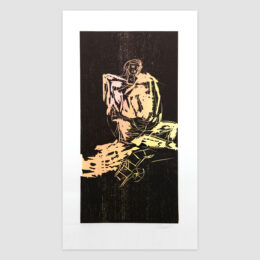


Georg Baselitz is a German painter and printmaker known for his inverted, or “upside-down,” paintings. He began creating prints in the 1960s, using techniques such as lithography, etching, and woodcut. Baselitz’s prints often depict the same subjects as his paintings, including figures and landscapes, but in a more graphic, simplified style.
Georg Baselitz has always created art that stays well away from the mainstream. He rejected the abstract art that was dominating Modernism in the 1950s and 60s and became a Post-Modernist painter, print maker and sculptor. His work has had a big impact on Neo-Expressionist art in Germany. Baselitz attended the Academy of Art in East Berlin for one year (1956) and completed his art training at the Academy in West Berlin. His influences include Existentialism Dada and Art Brut. Most of Georg’s images features stylised figures with exaggerated attributes that are intended to be symbolic. His first solo exhibition of paintings, shown at a Berlin gallery in 1963, outraged the public and resulted in several works being confiscated for indecency.
In 1965 Georg Baselitz went to Florence, where he developed an interest in the revolutionary prints produced by Italian Mannerists. These inspired him to produce what he called his Hero series, a set of images showing battle-scarred soldiers, badly wounded and scarred. From 1969 Baselitz began to paint his subjects upside down, because he felt that artists should focus less on the appearance of an image they are trying to recreate in paint and art should be more about using the medium as a means of expression and to create a balanced form. In 1979 he began a series of sculptures, depicting human heads and figures, roughly hewn from wood and painted. From 1977 to 1982 Georg Baselitz was Professor of Painting at the State Academy of Fine Arts in Karlsruhe and from 1983 to 1988 he taught at the College of Fine Arts in West Berlin.